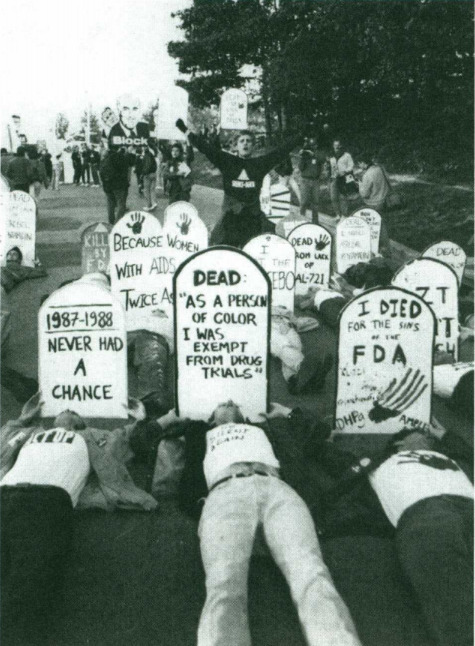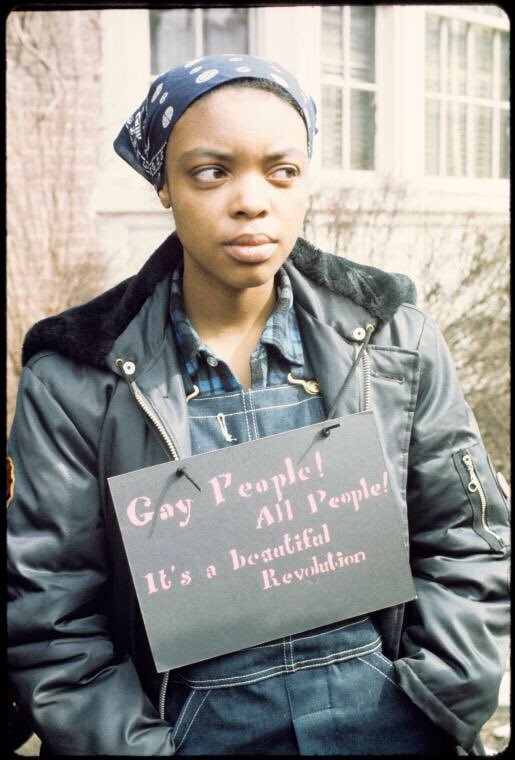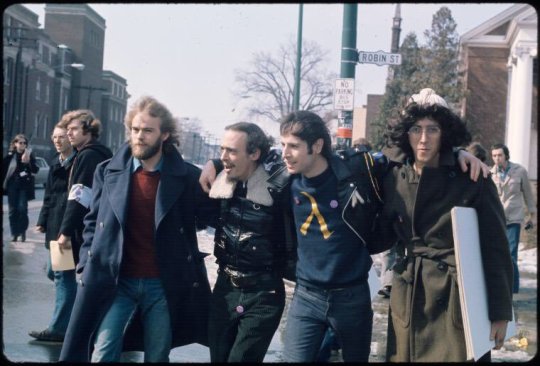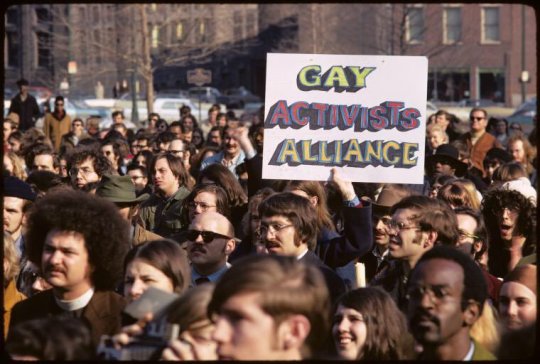American history: so much more interesting than you've been led to believe. A supplement to Washington State's 8th grade US History curriculum, in which we don't "skip all the cool stuff."
Don't wanna be here? Send us removal request.
Video
youtube
4 notes
·
View notes
Photo

I wish I had specific information about this pic but I don’t, here’s what the blurb under it said in the encyclopedia I got it from:
Activism by ACT UP and other groups, such as this protest dramatizing the wide-ranging targets of AIDS, helped to raise public consciousness about the breadth of [it], and governmental negect.
12K notes
·
View notes
Photo

Outline of human figure with writing “Lost Angeles” on column at homeless camp in Los Angeles, California, 1987.
Los Angeles Times Photographic Archives (Collection 1429). UCLA Library Special Collections, Charles E. Young Research Library, UCLA.
13 notes
·
View notes
Photo

Photograph of Sandra Day O'Connor Being Sworn in a Supreme Court Justice by Chief Justice Warren Burger, Her Husband John O'Connor Looks On, 9/25/1981
Series: Reagan White House Photographs, 1/20/1981 - 1/20/1989. Collection: White House Photographic Collection, 1/20/1981 - 1/20/1989
Announced as President Reagan’s intended nominee on July 7, 1981, and formally nominated on August 19, Sandra Day O’Connor was sworn in as the first woman Justice of the U.S. Supreme Court thirty-five years ago on September 25, 1981. O’Connor worked as a lawyer and then a judge in Arizona before becoming an Associate Justice in the U.S. Supreme Court. She retired in 2006.
146 notes
·
View notes
Link
Dolores Madrigal remembered being told that her sterilization could be reversed. Jovita Rivera and Georgina Hernández said they were bullied by doctors and nurses who declared their children burdens on California taxpayers. Melvina Hernandez did not find out that her tubes had been cut until four years after her son was born.
In 1975, these four women were among the 10 plaintiffs who filed a class-action lawsuit in federal court claiming that the Los Angeles County U.S.C. Medical Center was systematically sterilizing Spanish-speaking mothers who delivered their babies via cesarean section.
Madrigal v. Quilligan was, from its outset, the kind of striking David-versus-Goliath story that Hollywood and history books usually love — Erin Brockovich with an East L.A. twist. It was championed by a Latina fresh out of law school, and backed by the marginalized feminist wing of a growing Chicano activist movement. It was directed against some of most the powerful institutions in the state, including the Department of Health and the University of Southern California. The events in the trial even had a famous setting: For decades, Los Angeles County hospital served as an exterior shot for the soap opera “General Hospital.” And the claims were disturbing — that the hospital had made a practice of misleading women about sterilization and coercing them into giving consent.
5 notes
·
View notes
Photo




Gay rights demonstration, Albany, New York, 1971
9K notes
·
View notes
Link
It’s worthwhile for anyone who wants to see social change today to understand exactly how the wheels came off the black and leftist social movements of the 1960s.
#GhostCurriculum#hippies and revolutionaries#Black Panthers#Altamont#Weathermen#the left eats its own young#COINTELPRO#the government also eats our young
8 notes
·
View notes
Text
The Refugees
The 1968 U.S. Marine Corps training film instructs U.S. soldiers in Vietnam on how to take care of civilian refugees seeking assistance.

Another C-SPAN historical film, this was originally produced by the US Marine Corps to train Marines in how to treat refugees from the conflict between the Vietcong and the US-backed Republic of Vietnam.
1968 was one of the most violent years of the war. From a Marine Corps history:
The year 1968 was the year of the Tet Offensive including Khe Sanh and Hue City. These were momentous events in the course of the war and they occurred in the first three months of the year. ... The bloodiest month of the war for the U.S. forces was not January nor February 1968, but May 1968 when the Communists launched what was called their "Mini-Tet" offensive. This was followed by a second "Mini-Tet" offensive during the late summer which also was repulsed at heavy cost to both sides. By the end of the year, the U.S. forces in South Vietnam's I Corps, under the III Marine Amphibious Force (III MAF), had regained the offensive. By December, enemy-initiated attacks had fallen to their lowest level in two years. Still, there was no talk of victory. The Communist forces remained a formidable foe and a limit had been drawn on the level of American participation in the war.
The
1 note
·
View note
Link
1 note
·
View note
Text
The Last Two Days

Another C-SPAN historical film, The Last Two Days documents President John F. Kennedy’s trip to Texas in 1963.
From Kennedy’s last public speech, given the morning he was assassinated:
This is a very dangerous and uncertain world. ... We are still the keystone in the arch of freedom, and I think we will continue to do our duty. I’m confident, as I look to the future, that our chances for security, our chances for peace are better than they were in the past. With that strength is a determination to not only maintain the peace, but also the vital interests of the United States.
During my childhood, American adults of my parents’ and grandparents’ generations could all remember where they were when they heard that Kennedy was shot. In my own adulthood, the most similar “we all remember where we were” historical moment has been the September 11 attacks.
#GhostCurriculum#nope can't get through this without crying#Kennedy was so important to my Nana#and to a lot of other Roman Catholics who'd faced prejudice for their faith#Southwest
0 notes
Photo



UFOs, the U.S. Government, and the Space Age
Today in America there seems to be an increase fascination with aliens and UFOs. One of the most infamous reports of a UFO crash happened on July 8, 1947 outside the New Mexico town of Roswell.
In celebration of that event, we wanted to share some information about a visit between NACA’s (National Advisory Committee for Aeronautics– the predecessor of NASA) Western Coordination Officer, Edwin P. Hartman and John K. Northrop of Northrop Aircraft. Mr. Hartman would often travel to different aerospace companies and would document industry activities. On May 3, 1950, Mr. Hartman went on a scheduled visit to Northrop Aircraft Inc. and met with Mr. John K. Northrop. During Mr. Hartman’s visit, Northrop told him privately that he thought atomic powered saucers from other planets were possible. Mr. Northrop also stated that some Northrop men flying a P-61 in the Fort Worth TX area chased a bright aerial object (possibly a flying saucer?) but had to abandon the chase before reaching the object because of lack of oxygen. A B-36 was sent to continue the chase but it was unsuccessful.
Also posted is the original memo (without the UFO discussion) of Mr. Hartman’s visit to Northrop Aircraft, Inc. indicating that they discussed missile development and the development of computing machines. Northrop’s computing machine named “Mad Ida” could gobble data 10 times faster than MIT’s computing machine.
Series: Confidential Reference Memorandums, 1940-1962. Record Group 255: Records of the National Aeronautics and Space Administration, 1903 – 2006.
60 notes
·
View notes
Link

#GhostCurriculum#women's history#there are so many great reasons to be on hormonal birth control#migraine prevention#anemia#and of course not having babies until you're ready
1 note
·
View note
Link
6 notes
·
View notes
